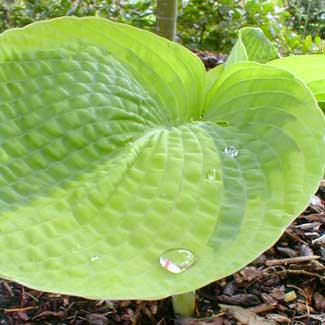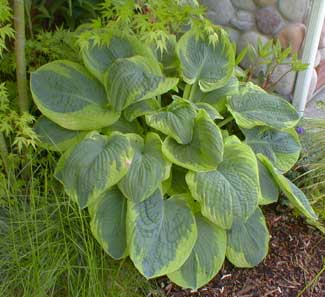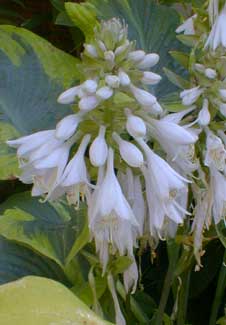
'Frances Williams'
Siebold Plantain Lily
"Here the frailest leaves of me,
and yet my strongest-lasting:
Here I shade & hide my thoughts."
-Walt Whitman
(1819-1892)
(1819-1892)
'Frances Williams' is a large variegated sport of Hosta sieboldiana 'Elegans.' It has a blue-green center with a wide golden-green margin. It grows to two feet height not counting flower stalk, & the clump spreads four to six feet over time.
The three photos on this page are of three different specimens in May, among several planted in shade to bright shade at a friend's estate where I've done some landscaping & maintenance.
 It's the very variety credited with sparking the modern interest in new hosta varieties, a fad that began before World War II. It has remained always in the top ten most popular cultivars.
It's the very variety credited with sparking the modern interest in new hosta varieties, a fad that began before World War II. It has remained always in the top ten most popular cultivars.The leaves are sometimes more rounded than for most hostas, but elsetimes the leaves are heartshaped like the usual.
The golden-green margin varies a great deal too, some specimens having a thinner boarder, some a wider border, & as can be seen in the first photo, sometimes the lighter coloration is not restricted to the rim.
It is possible to separate out unique segments of this hosta & preserve slight variations, which is why strains from different sources can be quite different.
 Off-white flowers rise above the bright foliage in July & August, a bit showier than most hostas, though its hard for the blooms to compete with the leaves for attention.
Off-white flowers rise above the bright foliage in July & August, a bit showier than most hostas, though its hard for the blooms to compete with the leaves for attention.The species is named for the German physician & botanist Philipp Franz von Siebold (1796‚1866) who sparked general interest in hostas in the early 1800s after he returned to the Netherlands with several specimens he had collected over time during his long stint as a physician in Nagasaki for the Dutch East India Company. (I've written an article about Dr. von Siebold as part of the 'Plumosa Compressa' Dwarf Sawara Cypress page.)
The cultivar is named for Mrs. Frances Ropes Williams (1883-1969) of Winchester Massachusetts, who spotted & quickly obtained the first known specimen when it appeared in a field of H. sieboldiana at Bristol Nurseries in Connecticutt, in 1936.
Mrs. Williams was a devoted hosta enthusiast & founding member of the American Hosta Society. She bred & named many introductions developed in her private garden.
Her yard was a scant third of an acre shaded by large nearby trees & the ground was rather damp. When she discovered how well hostas thrived where sun-loving perennials would not, she went a bit, well, overboard, so that her third-acre plot lent her an international reputation I'm sure was very much a surprise to her.
She named the variety 'Yellow Edge,' being not vain enough to name it for herself, while a Des Moines Iowa nurseryman turned her name for it into Latin as 'Aureus Marginata' which was soon amended to Aureo-marginata.
In the very early 1960s, Mrs. Williams sent a root to George R. Robinson of the Oxford University Botanic Garden. He not long after displayed the plant during a botanical lecture, & having forgotten it had been named 'Yellow Edge,' named it in honor of the woman who discovered & cultivated the first one.
He published his lecture in 1963, & slowly the name he selected came to be preferred, being as it was an honor richly deserved by a tireless promoter of hostas.
This Award of Garden Merit recipient likes moist well-draining humusy rich soil in shade or bright shade, but adapts well to less than ideal conditions, including droughtiness or considerable sunlight or poorer or heavier soil. Too much direct sun can scorch the leaves, but as with most hostas, they can take more sunlight than most people realize.
It is, however, their ability to fill in shady areas that makes them so popular. Their sole drawback is snails & slugs love them & the gorgeous leaves can quickly be spoilt. The surest way to protect them is to go out nights with a flashlight & pluck snails & slugs out of the garden. Most baits don't work anywhere near well enough to save the hostas, but see my article Iron Phosphate: The First Honestly Effective Snail & Slug Bait.